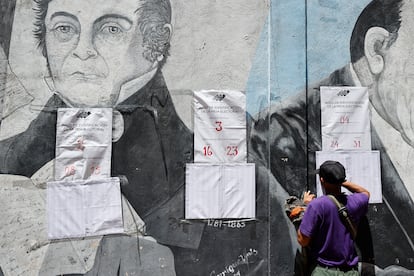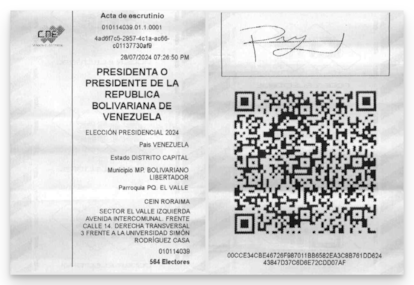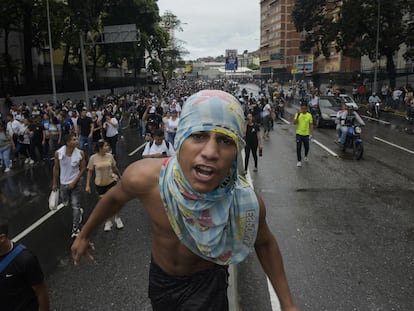Who won the Venezuelan election? Opposition data is more verifiable than the official figures
The lack of transparency has made it extremely difficult to verify the results. But the opposition has so far presented more detailed information and allowed its numbers to be scrutinized, which gives them more credibility

Four days after Venezuela’s July 28 election, there are growing suspicions of electoral fraud. The ruling party-controlled National Electoral Council (CNE) declared President Nicolás Maduro the winner on Sunday, giving him 51.2% of the vote, compared to 44.2% for his rival, opposition candidate Edmundo González. In its announcement, it described the results as “irreversible,” bypassing the transparency and integrity procedures required, and without providing any data to facilitate verification of its claims. At the same time, the opposition has claimed a comfortable victory, 67% to 30%, based on more than 24,000 voter tallies of which it claims to have a copy. These tallies have been posted on a website, which has joined other sites that are sharing similar data.
Given this discrepancy, what can be concluded? My opinion is clear now: the data provided by the opposition is more in-depth and more verifiable.
The Maduro government’s data is poor
On Sunday night, the CNE announced the election results with a bulletin containing just six figures: three voting figures — for Maduro, Edmundo González and “others” — and three corresponding percentages. These percentages were made when the CNE said the count was at 80% and indicated an “irreversible” trend. But since then, there has been no further update. Four days have passed, and although it is shocking and goes against established procedures, the government has not offered any further data on the election results.
The CNE has not published the tally sheets or the full results. In Venezuela, there is electronic voting. The electronic machines provide every voter a paper receipt that shows which candidate they chose. Voters are supposed to deposit their receipts at ballot boxes before exiting the polls. After polls close, each machine prints a tally sheet showing the candidates’ names and the votes each received. These tally sheets are given to present and parties, and sent electronically to the CNE, which is in charge of calculating the totals. The CNE was supposed to publish the results, broken down by polling center and electronic machine, based on the tallies, but in the middle of the night on Sunday, its website stopped working. It is still not online.
The government has also not provided the verification records, which certify that the planned Citizen Verification Audit (which compares a count of the paper receipts to confirm the machine’s printout is correct) was successfully carried out.
No subnational results have been offered either. The CNE has not published the results of the vote by municipality or by region. It has only released a handful of total figures from Sunday night.
As if that were not enough, the six-figure results offered by the CNE are also suspicious. Why? The voting figures for “Maduro,” “Edmundo,” and “Others” coincide with an exact percentage of votes up to the sixth decimal. It would be extremely rare for such a result to happen by chance: it is difficult for it to happen with one candidate — the odds are one in a thousand —, but for it to happen with two candidates, the odds are one in a million.
What’s behind this exactitude? The easiest explanation is to imagine that the number of votes offered by the CNE is a figure calculated from percentages: they started from the total votes (10,058,774), took a round percentage, like Maduro’s 51.2%, and with that, they calculated his votes: 5,150,092.288. Since it is absurd to give results with decimals, they left it at 5,150,092. That is why the percentages would be almost be rounded numbers, but not completely, only to the sixth decimal. It is not impossible to believe that those percentages are the correct ones, and that the CNE calculated the votes from them instead of using the votes actually counted, but it is a strange method, to say the least.
The opposition’s data is much more in-depth
After spending the morning gathering information, the opposition held a press conference on Monday afternoon and announced that they had obtained 73% of the voting tallies. The results of these paper receipts contradicted the CNE’s figures, and gave them the victory. Since then, the opposition has continued to collect tally sheets and has posted them on various websites. The most recent update, made on Thursday, claims to contain 24,576 tallies, which is 81.8% of the total. Anyone can search for a vote, consult the detailed results and even download a scanned copy.

Each record contains a lot of information: all the results of the polling station, a QR code version of them, their identifier, the date and time of closing, a security hash chain, and the name and signature of the members of the polling station, the witnesses and even the operator of the voting machine. The records are an essential element to clarify the result of the election, because they are potentially verifiable. For example, their information can be compared with other paper documents from the day, such as the tallies of the Verification Audit.
Unlike the CNE, the website that the opposition has published with the tally sheets offers the results in each parish, municipality and Venezuelan state, allowing users to analyze the figures.
I myself have been able to access the tabulated data of 997 of these polling stations. I have used the subset that was processed by an independent civil society group, which prefers not to be named for fear of repression, and validated by a group of academics from the Federal University of Pernambuco and the University of Michigan. Before the elections, they chose 1,500 representative polling stations in the country, with pre-registration. They obtained information from 997 tally sheets at the 1,500 polling stations, and from there, applying a formal and documented methodology, they produced an estimate of the final result: 66% for Edmundo González and 31% for Maduro.
A thorough audit of these data takes time, but my first impression is positive — in the past I have handled data from dozens of elections in many countries. For example, in the first graph, I show the votes for Maduro and Edmundo for each polling station. I have calculated their percentages and marked those tally sheets with whole percentages, which are few, as to be expected.
In this second graph, I have taken voting data from more than 200 Venezuelan parishes and cross-referenced it with a socioeconomic indicator provided by the Venezuelan National Institute of Statistics. It is just an example, but a plausible pattern appears: according to the data from the voting records, Maduro won more votes in the most disadvantaged regions.
The conclusion is simple: the Maduro government has barely provided any data to support its declaration of victory, while the Venezuelan opposition has set up an operation to collect and present thousands of records. It offers more information, is more transparent, has opened itself to evaluation and scrutiny, and in this way, has increased the credibility of its results.
The only alternative for Chavismo is to undertake a very rapid exercise in transparency. Or perhaps it is already too late? Suspicions of irregularities are growing with each day the ruling party keeps the country in the dark.
Sign up for our weekly newsletter to get more English-language news coverage from EL PAÍS USA Edition
Tu suscripción se está usando en otro dispositivo
¿Quieres añadir otro usuario a tu suscripción?
Si continúas leyendo en este dispositivo, no se podrá leer en el otro.
FlechaTu suscripción se está usando en otro dispositivo y solo puedes acceder a EL PAÍS desde un dispositivo a la vez.
Si quieres compartir tu cuenta, cambia tu suscripción a la modalidad Premium, así podrás añadir otro usuario. Cada uno accederá con su propia cuenta de email, lo que os permitirá personalizar vuestra experiencia en EL PAÍS.
¿Tienes una suscripción de empresa? Accede aquí para contratar más cuentas.
En el caso de no saber quién está usando tu cuenta, te recomendamos cambiar tu contraseña aquí.
Si decides continuar compartiendo tu cuenta, este mensaje se mostrará en tu dispositivo y en el de la otra persona que está usando tu cuenta de forma indefinida, afectando a tu experiencia de lectura. Puedes consultar aquí los términos y condiciones de la suscripción digital.
More information
Archived In
Últimas noticias
Trump claims peace in Ukraine is near, but Moscow suggests otherwise
A survivor’s account of the Interoceanic Train accident: ‘We were scared because of the speed on the curve’
The Interoceanic Train, the Mexican alternative to the Panama Canal
What is known about the Interoceanic Train derailment in Oaxaca
Most viewed
- Oona Chaplin: ‘I told James Cameron that I was living in a treehouse and starting a permaculture project with a friend’
- Reinhard Genzel, Nobel laureate in physics: ‘One-minute videos will never give you the truth’
- Why the price of coffee has skyrocketed: from Brazilian plantations to specialty coffee houses
- Pablo Escobar’s hippos: A serious environmental problem, 40 years on
- Chevy Chase, the beloved comedian who was a monster off camera: ‘Not everyone hated him, just the people who’ve worked with him’











































